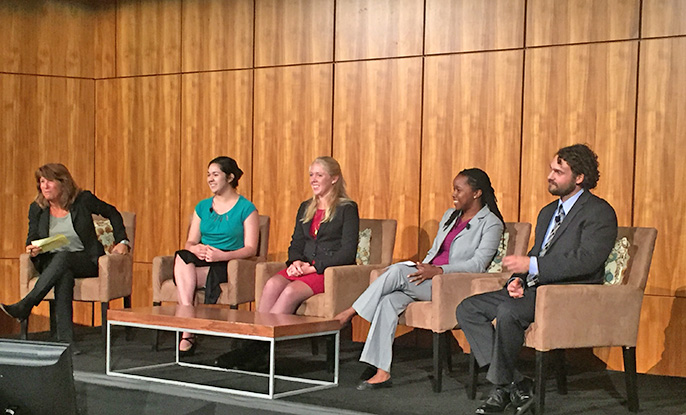Andy Murdock, UC Newsroom

What happens to anesthetics after a patient inhales them? UCSF anesthesiology resident Nicole Jackman wants doctors to think carefully about that question, because not only are inhaled anesthetics potent sleep inducers, they’re also extremely potent greenhouse gases.
Jackman is one of some three dozen students across the UC system to be awarded a Carbon Neutrality Initiative Student Fellowship for the 2015-16 academic year. Part of UC’s push to become carbon-neutral by 2025, the UC President’s Carbon Neutrality Initiative Student Fellowship Program funds undergraduate and graduate student projects that help get the UC system closer to this goal.
The student projects are as bold as they are broad, ranging from research into next-generation clean energy technologies to large-scale efforts like the Cool Campus Challenge that get students directly involved with the university’s carbon neutrality goals. Some projects might come as a bit of a surprise, like Jackman’s focus on hospitals.
“The healthcare sector represents 8 percent of the U.S.’s carbon footprint,” said Jackman. “Hospitals use a lot of energy — as much as 3,500 households over the course of a year. There’s clearly room for energy efficiency in the sector and large benefits if hospital infrastructures can be made more efficient.”
As an anesthesiologist, Jackman is zeroing in on what can be done to improve hospital anesthesia practices. The most commonly used inhaled anesthetics, including nitrous oxide and fluorinated ethers like desflurane, have global warming potentials that range from 300 to 1,500 times that of carbon dioxide. Once exhaled by patients, these gases go straight through a hospital’s ventilation system to the outside air.
Moderating the use of anesthetics without affecting patients can limit the effects on climate change and can save hospitals significant amounts of money, around $1 million per anesthesiologist over one's career, Jackman estimates. In the future, recapture and reuse of gaseous anesthetics is a definite possibility.
The 10 UC campuses, Lawrence Berkeley National Laboratory, the Division of Agriculture and Natural Resources and the UC Office of the President each received $12,000 to divide among the selected student projects. The next call for Carbon Neutrality Student Fellows will occur in spring of 2016.

Credit: Sara McKinstry, UC San Diego
The 2015-2016 Carbon Neutrality Initiative Student Fellows
Agriculture and Natural Resources
- Kripa Jagannathan (UC Berkeley): Bridging the gap between climate model outputs and farmer decision-making
- Kyle S. Hemes (UC Berkeley): Restoring California’s peatlands: coupling biogeochemical and biogeophysical impacts on the climate
- Connor Stephens (UC Berkeley): Evaluating the efficiency of mechanical fuel treatments in mitigating high severity fire in western pine forests
Lawrence Berkeley National Laboratory
- Estella Shi and Daniel Xu (UC Berkeley): Energy management activities: expanding operational energy management capability for Berkeley Lab
UC Berkeley
- Lindsey Agnew: Cool Campus Challenge and Carbon Neutrality Initiative communication and engagement
- Sarah Strochak: Carbon neutrality events and mapping campus carbon hot-spots
- Charlotte O'Donnell: Climate action planning
UC Davis
- Bethany Celio, Alex Lee and Naftali Moed: Campus engagement and outreach
- Colin Mickle: Carbon offset research
UC Irvine
- Kimberly Duong: Climate action planning project
- Sarah Geldmacher: Regional climate resilience project
UCLA
- Katie Luong: Cool Campus Challenge and communications strategy
- Joanne Wong and Ariana Vito: Carbon neutrality planning and scenario analysis
UC Merced
- Gabriel Morabe: Student engagement and communications efforts
- Chelsea Coe: Research on climate communication
- Adriana Gomez: Updating the UC Merced climate action plan
UC Office of the President
- Lauren Jabusch (UC Davis) and Amaia Schultz (UC Berkeley): Carbon Neutrality Initiative engagement support
- Benjamin Rushakoff (UC Berkeley): Greenhouse emissions inventory for UCOP operations
UC Riverside
- Hannah Campi: Campus Engagement Fellow
- Benjamin Sommerkorn: Conduit hydrokinetic turbine feasibility study
- S. Drew Story: Green Lab and Green Event certifications
- Chao Wang: Carbon footprint tracking network
UC San Diego
- Lesly Figueroa: Communication development for UC sustainability goals and programs
- Jess Gambel: Growth, pollination and fruit production of Cucurbita pepo
- Yanqi Luo: Delivering renewable energy goals at UC San Diego
- Jiarong Zhou: Building a Thole-Type Model (TTM) of methane hydrate
UC San Francisco
- Alex Schrobenhauser-Clonan: Lessons from medicine for the climate change diagnosis
- Nicole Jackman: Efficient use of fresh gas flow with inhaled anesthetics can decrease costs and impact medical greenhouse gas emissions at UCSF
UC Santa Barbara
- Colleen McCamy: Cool Campus Challenge; Santa Barbara Coastal Long Term Ecological Research
- Rob Holland: Cool Campus Challenge
- Maximilian Salvador Stiefel: Best practices for carbon neutrality
UC Santa Cruz
- Jordi Vasquez and Jamison Czarnecki: Cool Campus Challenge and student outreach

